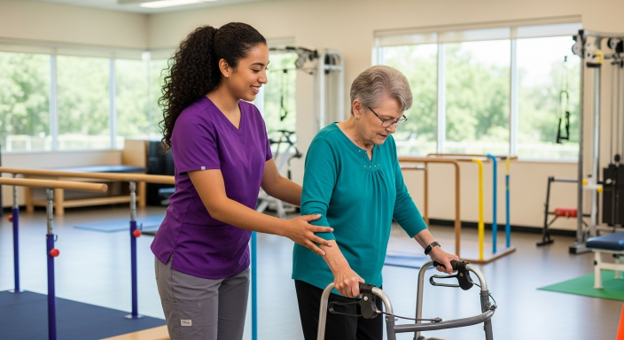How Gen Z is Redefining the Role of the Occupational Therapy Assistant
Published - July 20, 2025


Table of Contents
A Career Where Compassion Meets Innovation
Picture a career where you’re not only helping someone regain their independence but also blending hands-on care with cutting-edge technology. This is the heart of the Occupational Therapy Assistant (OTA) role—a profession where compassion is key, creativity is celebrated, and every day offers a chance to change lives for the better.
For Generation Z, this balance of heart and innovation is what makes being an OTA so appealing. As one of the fastest-rising roles in healthcare, the OTA profession is evolving rapidly, thanks to the passion, skills, and values of this dynamic generation. With their drive to make a difference and their knack for rethinking traditional systems, Gen Z is leaving a profound mark on this field.
Let’s dive into what OTAs do, how Gen Z is shaking things up, and why this career holds exciting possibilities for those who want a job fueled by purpose and impact.
What an OTA Does Every Day
Simply put, Occupational Therapy Assistants are the ones who step in to help patients rediscover independence and confidence. They take what occupational therapists create—a road map for a patient’s recovery—and bring it to life. Whether that means guiding a patient through exercises, teaching them how to use adaptive tools, or just cheering them on when things get tough, OTAs are there for every step of the journey.
You’ll find OTAs working in places like hospitals, rehab centers, clinics, schools, and even patients’ homes. They might help a child with developmental needs gain motor skills through playful activities or guide a senior citizen recovering from surgery to regain mobility and self-reliance. The work is varied but universally rewarding.
With a growing demand for occupational therapy services—thanks to an aging population and expanding access to healthcare—the OTA role is more relevant than ever. And with Gen Z bringing fresh energy to the profession, its impact continues to grow.
How Gen Z Is Leading Change in the OTA World
Generation Z—those born between 1997 and 2012—has officially entered the workforce, and they’re redefining what it means to be an OTA. Their tech-savviness, commitment to diversity, and focus on meaningful careers are reshaping the field in some pretty amazing ways.
Bringing Tech into Therapy
For Gen Z, technology isn’t just a tool—it’s like a second language. And in the OTA world, they’re using it to revolutionize care. Think telehealth sessions connecting patients in rural areas, therapy apps that guide at-home exercises, or even virtual reality experiences that turn rehab into an interactive adventure.
Take pediatric therapy, for example. Gen Z OTAs might use gamified apps to make exercises fun for kids or leverage wearables to track progress in real time. They’re finding new ways to reach, teach, and treat patients in ways that improve care while making it more accessible.
Putting Inclusion at the Forefront
Inclusivity is more than a buzzword for Gen Z—it’s a driving philosophy. They’re advocating for patient care that’s culturally informed and deeply personalized.
Imagine working in a school setting where students come from diverse backgrounds with different languages and customs. Gen Z OTAs collaborate with bilingual interpreters or bring in visual communication aids to make therapy more relatable. By adapting care to a patient’s world, they’re setting a new standard for respect and trust in healthcare.
Choosing Careers with Purpose
What motivates Gen Z? It’s a desire to make a real difference. OTAs offer the perfect balance: hands-on work that improves lives and the chance to address larger social issues like mental health awareness and healthcare equality.
Collaboration also plays a big role in their success. Gen Z OTAs thrive in team environments, working alongside physical therapists, speech-language pathologists, and others to provide comprehensive care. For them, it’s about creating success stories through shared efforts and creative solutions.
How to Become a Certified OTA
If you’re inspired by this impactful career, the path to becoming a Certified OTA (COTA) is clear and rewarding. Here’s how it works:
- Enroll in an accredited program: Start with a two-year associate degree that covers the basics, like anatomy and therapeutic techniques.
- Dive into hands-on learning: Fieldwork placements give you a chance to make real connections with patients and hone your practical skills.
- Pass the NBCOT exam: After graduation, you’ll take the National Board Certification exam to earn your official COTA title.
- Complete state licensure requirements: Most states require additional steps to fully qualify you to practice.
Beyond the technical training, Gen Z OTAs also lean on their strengths—empathy, adaptability, and problem-solving—to navigate tricky situations and build solid relationships with their patients.
Where This Career Can Take You
One of the amazing aspects of being an OTA is the variety of settings you can work in.
- Schools: Help kids with challenges build confidence and skills for their academic and social journeys.
- Home health: Support seniors or recovering patients adjust to daily life within the comfort of their homes.
- Outpatient clinics: Focus on recovery plans for people healing from injuries or surgeries.
- Telehealth: Use virtual tools to connect with patients no matter where they live.
For Gen Z, these options provide the flexibility and stimulation they crave, while offering countless ways to make an impact.
Building a Legacy
Generation Z isn’t just shaping the occupational therapist assistant profession—they’re elevating it in ways that will ripple far into the future. They’re showing us how technology, inclusion, and a passion for meaningful work can blend to create care that’s more human, more impactful, and more accessible.
As they continue to push the boundaries, they’re inspiring others to see this career not just as a job but as an opportunity to create lasting change. So if you’re ready to step into this exciting field, you’ll not only be joining a profession on the rise—you’ll be part of a movement that’s making healthcare better, one patient at a time.
